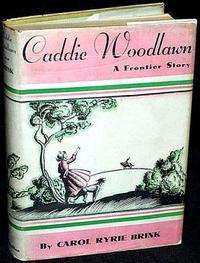Caddie Woodlawn
 | |
| Author | Carol Ryrie Brink |
|---|---|
| Country | United States |
| Language | English |
| Series | Caddie Woodlawn |
| Genre | Children's Historical Fiction |
| Publisher | Simon & Schuster Children's Publishing |
Publication date | 1936 |
| Media type | Print Hardback |
| Pages | 275 |
| ISBN | 1-4169-4028-6 |
| OCLC | 77530618 |
| Followed by | Magical Melons |
Caddie Woodlawn is a children's historical fiction novel by Carol Ryrie Brink which received the Newbery Medal in 1936 and a Lewis Carroll Shelf Award in 1958. The original edition was illustrated by Newbery-award winning author and illustrator Kate Seredy. Macmillan released a later edition in 1973, illustrated by Trina Schart Hyman.[1]
Plot
Set in the 1860s, it is about a lively eleven-year-old tomboy named Caroline Augusta Woodlawn, nicknamed "Caddie", living in the area of Dunnville, Wisconsin. As a young girl she made the journey from Boston to Dunnville with her family, one which nearly cost her life. Sickly and weak, she is allowed to run wild with her brothers, Tom and Warren, to regain her health. They spend much of their time exploring the woods and rivers that surround their farm. The book opens with Caddie, late for dinner after an excursion to visit the local Indian tribe, embarrassing her mother with her antics. She, undaunted, spends the next year having a string of adventures and scares. From a midnight ride through the forest to warn her friend “Indian John” that the settlers are planning an attack, to a prairie fire that brings out the best in Obediah, a schoolhouse bully, to a life-threatening fall through a lake while ice skating, her life is far from boring. Things come to a head when “perfect” Cousin Annabelle from Boston arrives for a visit and Caddie is forced to confront her future. Tom and Warren, always a part of her adventures, come along for the journey. This story is full of practical jokes and touching moments like the long journey home of Nero, a beloved pet. It is the true story of a family’s existence on the frontier during the Civil War, and offers insights into how life was lived in a small Wisconsin village where fear of local Indians was a reality and life and death situations arose with frightening regularity. The sequel, Magical Melons (1939), continues the story of Caddie and her family.
Background
Brink was born and raised in Moscow, Idaho, in the Palouse region.[2][3] Orphaned at age eight following her mother's suicide, she lived in Moscow with her widowed maternal grandmother and an unmarried aunt;[4] the grandmother had grown up on a farm in Wisconsin.[5] In a preface to the later edition of Caddie Woodlawn, she said the books were partly based on the life of her grandmother, Caddie Woodhouse Watkins (1853–1940),[6] and her siblings: older sister Clara, older brother Tom, younger brother Warren, younger sisters Hetty and Minnie, and baby brother Joe.[1]
The house where Caddie lived is now a historical site, about 12 miles (19 km) south of Menomonie, Wisconsin.
Critical reception
Children's literature expert May Hill Arbuthnot says of Caddie Woodlawn, "this book is far less of a frontier story—settlers versus Indians—than it is the entertaining evolution of a tomboy. The fun Caddie gets out of life suggests the usefulness of this book in counteracting the overseriousness of most historical fiction."[7] Kirkus Reviews said it provides "an authentic picture of life on a frontier farm when massacre was a real threat and when a livelihood, hardly earned, allowed for fun in natural outdoor things".[8] It won the Newbery Medal in 1936.[9]
The book's portrayal of Native Americans has been criticized in more recent years. Debbie Reese, founder of the website American Indians in Children's Literature, shared her daughter's pained reaction to reading it in school in "Reflections on Caddie Woodlawn: Teaching about Stereotypes using Literature." [10]
Adaptations
Brink transformed Caddie Woodlawn into a radio drama in 1945.
In 1989, a made-for-television movie based on the novel was directed by Giles Walker with teleplay by Joe Wisenfeld and Richard John Davis. Emily Schulman portrayed her in the title role. Several changes were made from the book, most notably moving the conflict between the settlers and Indians toward the end, and greatly increasing the role of Annabelle, Caddie's cousin.
A musical, Caddie Woodlawn A Musical Adventure (The Caddie Woodlawn Musical), by Tom Shelton and Susan C. Hunter, Brink's granddaughter, was also based on the book.
References
- 1 2 Ryrie-Brink, Carol (1973). Caddie Woodlawn. New York: Simon and Schuster. ISBN 0027136701.
- ↑ "Reference Series: Carol Ryrie Brink, 1895–1981" (PDF). Idaho State Historical Society. January 1996. Retrieved November 18, 2012.
- ↑ Johnson, David (October 21, 1995). "Nature park dedicated at Moscow". Lewiston (ID) Morning Tribune. p. 7A.
- ↑ McCarthy, John (May 6, 1990). "Carol Ryrie Brink: Childhood in Idaho inspired her writing". Lewiston Morning Tribune. p. 8-Centennial.
- ↑ "Carol Ryrie Brink". Winning Authors: Profiles of the Newbery Medalists. p. 47. Retrieved 2012-05-27.
- ↑ "Caroline Woodhouse Watkins (1853-1940)". Find a Grave. Retrieved November 20, 2012.
- ↑ Arbuthnot, May Hill, Children and Books, Scott, Foresman, 1964, pg. 484;
- ↑ "Caddie Woodlawn". Kirkus Reviews. Retrieved 2012-05-27.
- ↑ "Newbery Awards". Retrieved 2012-05-15.
- ↑ Reese, Debbie. "Reflections on Caddie Woodlawn: Teaching about Stereotypes using Literature". American Indians in Children's Literature. Retrieved September 14, 2015.
External links
"Top 100 Children's Novels #93". School Library Journal. Retrieved 2012-05-20.
| Awards | ||
|---|---|---|
| Preceded by Dobry |
Newbery Medal recipient 1936 |
Succeeded by Roller Skates |